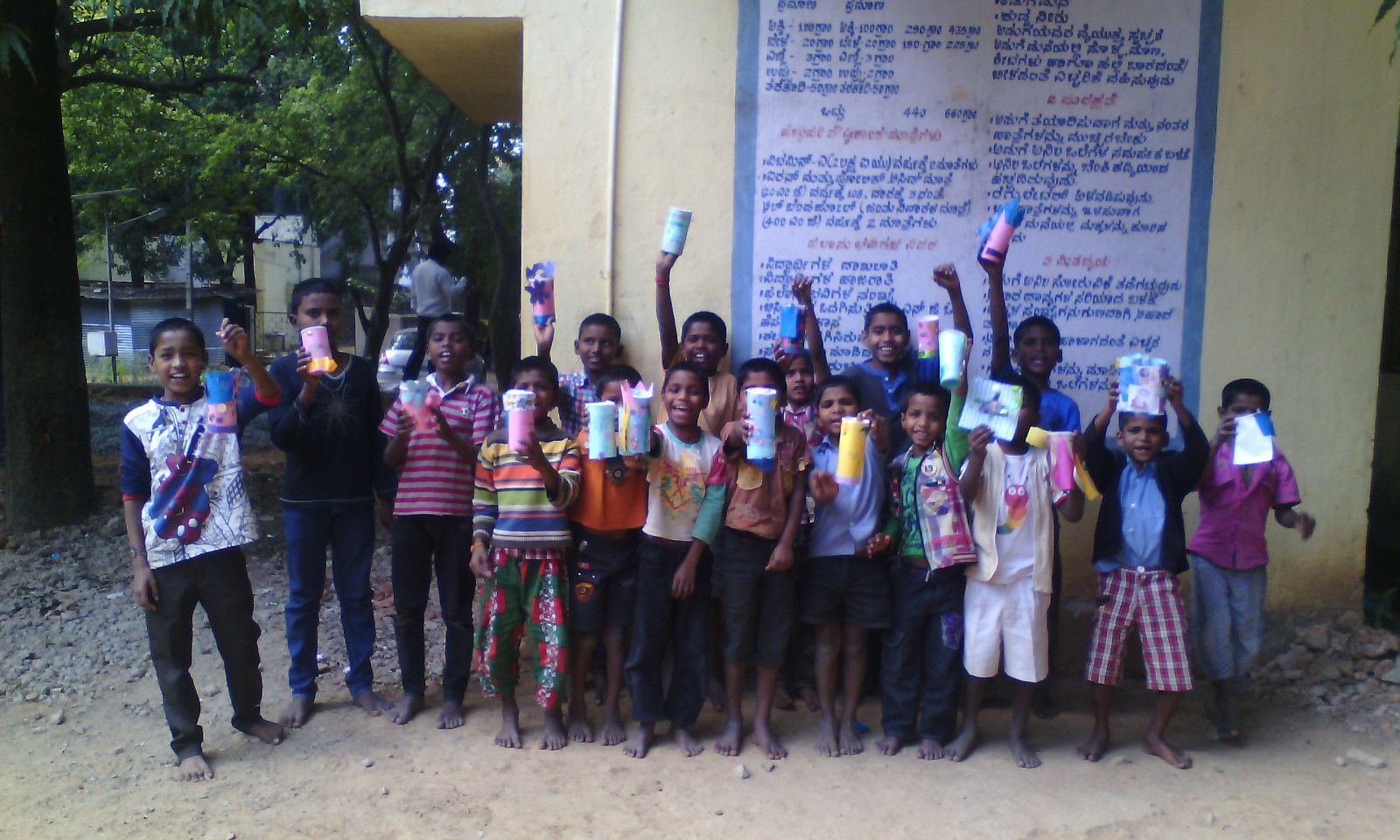At 17, Aparna Komarla runs ‘Live to Dream’, an organisation dedicated to make art accessible to underprivileged children
“I picked up sketching and pencil shading around the age of 10. As I grew older, I started to grow more attached to it. It helped me deal with difficulties in my mid-teens. I would create my own small world with my canvas, my heart and mind. The time I spent in front of the canvas, often sent me into moments of deep thought that would help me understand myself better and think with utmost clarity. It helped me open up boxes of emotion that I had previously kept shut and also deal with them.”

Aparna Komarla is 17 years old and studies in the 12th grade in Delhi Public School (DPS), Bangalore. She’s also the founder of Live to Dream, an NGO. The 17-year-old is clearly ahead of her age.The beginning
There were three main incidents that resulted in her starting Live to Dream.
The first was more of a long drawn experience. One summer, she decided to enroll in a class to learn some new art techniques. “I was at the class for nearly a month, when I decided to make an art piece that was creative and not in the books. When I put this across to my teachers, I felt a sense of discomfort and unacceptance. It wasn’t a good feeling, but what it made me realise was much more profound. When I would look around the class to see everyone painting, it was evident that most of the students were replicating or recreating art work. Only a handful were exploring and creating unique pieces from their own ideas. We were growing into a skilled bunch, but the balance between creative thinking and skill, in my opinion, was absent.”
She believes that we all require a strong set of skills, but in the process, we shouldn’t lose sight of our individual expression and creativity. “And this is where not just mine but several conventional art classes were falling out. I don’t think that one should have to remove themselves from conventional systems to achieve something; rather our systems need to adopt better models for education.”
The concept stuck with her, and later made one of Live to Dreams’ primary goals – empowering creativity.
The second incident was a realisation. Over the summer of 2014, she was trying to volunteer at a couple of NGOs but she wasn’t very happy with the work she was getting, and the impact. She decided to let that go and work individually. “The idea of teaching underprivileged children art, wasn’t new. It had always lingered in my head. I decided to pursue that and identified a home for destitute girls (NELE) close to where I live. I worked with them for three days, spending close to four hours each day. I planned to make one craft item on each day and provided them with all the materials, and most importantly asked them to be as creative and unique as they wished.”
The passion, curiosity, interest, and abilities she saw in them left her in awe. In her, developed a burning ambition to give opportunities to every disadvantaged child with an interest and curiosity a platform to learn art.
The third incident was also a realisation. She had just displayed her first painting in a prestigious gallery and received a lot of positive feedback and appreciation. “While I was taking in all of that, I thought about the workshop I had conducted at NELE. I was able to display my art because I had access to resources; resources that come from economic privileges.” She adds, “A great artist can come from anywhere. And for one to learn art, I didn’t think being born into an economically disadvantaged or otherwise disadvantaged family should be the defining factor of their learning pursuits.”
Aparna founded Live to dream in May 2014, when she was 16 years old. Live to dream aims at serving underprivileged kids. The first problem the organisation is tackling is that our education system has been conditioning the child in a singular and imposing pattern. Live to Dream wants to let the children’s imagination run free and wild, and let it be a way for them to communicate. The second problem they are trying to solve is the lack of opportunities for children from disadvantaged and economically challenging backgrounds.
Projects under Live to Dream’s umbrella

Art and Soul is a project where the Live to Dream team contacts shelter homes and schools for special children and carries out three- to four-hour-long art workshops with the children. The Live to Dream team brings all the material and covers the entire cost. All they ask from the school or a shelter home is the space to conduct the classes. Aparna shares, “We tell the children what each material is and what it can be used for. We encourage the kids to be as creative and different as they can. We make it clear that we are just giving them a basic structure to follow, but the rest is in their hands. We then split the kids up into groups of four or five and assign one volunteer to each team. We want the kids to have full authority over their art work.”The team has come out with 40 page art books that start with the very basics of drawing. It teaches kids how to hold a pencil to write/draw, the different types of lines (curved lines, straight lines, sleeping lines, etc.), how to draw, the techniques for pencil shading and smudging, and finally how to make three dimensional objects look real on paper. “We also tell kids through the book that if they have any other techniques that they have developed themselves, they shouldn’t be afraid to use them, but they have to practice to perfect them. We also have prompts like ‘Think of an incident in your life that has shaped your life and your personality’. Or ‘Think about an important lesson you have learnt from life and try to depict it in a drawing!’ We are trying to achieve that balance between developing their skills and empowering their creativity and imagination.”

The focus of Project X are teens. Being a teen herself, she understands this age group better than most, she states, “At some point during our teenage years, we’ve all faced emotional obstacles, with varying severity. From mild teasing/insults to violent domination, clinically diagnosed depression to slight emotional withdrawal. On opening up to a parent, one of these three outcomes can be expected – It’s brushed away, avoided or ignored; treated like it’s nothing because it isn’t ‘serious’ or threatening enough, it’s dealt with in-effectively, imprudently or unreasonably because of lack of knowledge and awareness. This is unfortunately quite common. And this project strives to change that.”The goals of this project are simple and profound – educating parents and guardians about teenage psychological issues, walking them through its root cause, effects and consequences, breaking the stigma and mental blocks associated with these issues to instill a sense of acceptance, providing prudent, rational and reasonable solutions, and spreading awareness on already existing solutions. The team has created a 10–12 page documents on various issues in teenagers like eating disorders, depression, and anxiety disorders. These documents throws light on the issue, the way to deal with it, busts myths, and gives links to additional resources available online.
Hurdles and impact
Aparna thinks the biggest challenge is getting people to understand the importance or relevance of what they are doing. She tells us that once, the owner of an orphanage told her that he didn’t want the children there to focus on things that are secondary like art, but focus on academics. “And that is a common conception, we trivialise these activities. While for some it’s simply recreation, for some it could be therapeutic or even life changing. And this doesn’t apply to only art, it could be any field,” she states.

Live to Dream has reached 150 underprivileged children through eight ‘Art&Soul’ workshops. Aparna adds, “We are working with DPS, Bangalore, we are publishing one document on the portal for parents each month. DPS has over 7,000 students. We have published the article on eating disorders and anxiety disorders.
We published an article on eating disorders on one of India’s leading online magazines. We published an article in Teachers’ Digest, a magazine for educators and parents. We also published an article on the Brain Magazine.”
On a parting note, Aparna shares an anecdote with us,
In an art workshop with a few destitute boys, the volunteers were split into groups of five kids each. One of the kids in my group seemed a little disconnected. We were making pencil holders out of paper and his was nowhere near completion. I asked him what he wanted to do with the structure given to him. He subtly hinted at his idea – ‘Staircase, door, windows’, he said, pointing at their positions on the cylinder we had made from paper. I was excited to hear his idea that was quite creative. I said, ‘you want to make a house with it!’ He hesitated and seemed unconfident, and dismissed his idea as a mistake. While I thought to myself what a great idea that was, I saw him gather material to make what all the other kids were making. He wasn’t going to pursue his idea. Once I observed this, I asked him to stop and asked him why he was doing that. I said, ‘you want to make this, so why aren’t you?’ He looked scared and he hesitated. It took a while for me to talk him into making his idea come alive. I told him that he didn’t have to do what the other kids were doing, and that it was okay to be stand out. And when he agreed, he enthusiastically gathered all the material and we made the house. Everyone at the shelter home was amazed. His smile and contentment that shone through left an indelible mark on me ever since.
That afternoon reiterated her cause for Live to Dream. Aparna realised that as educators, we need to focus on the individual’s need and not follow the herd mentality of rote learning.







![[Funding alert] HomeLane raises Rs 60 Cr from Stride Ventures, existing investors](https://images.yourstory.com/cs/wordpress/2017/08/Srikanth-Iyer-Co-founder-CEO-of-HomeLane.jpg)


![[Weekly funding roundup April 20-26] VC investment dips as startups resort to debt capital](https://images.yourstory.com/cs/2/220356402d6d11e9aa979329348d4c3e/funding-lead-image-1669386008401.jpg)
